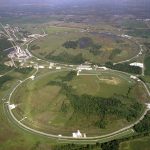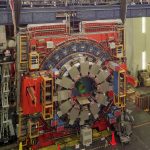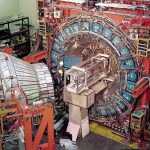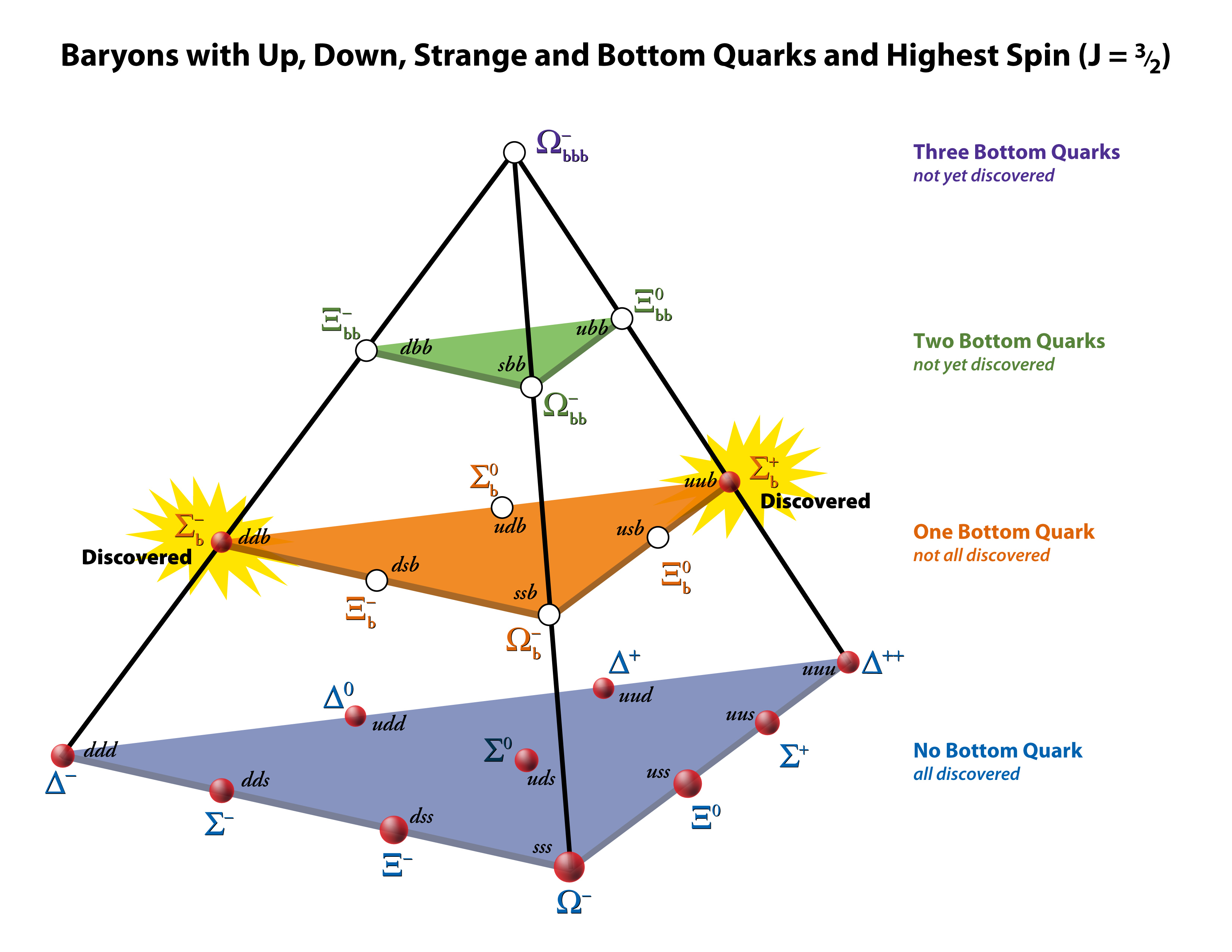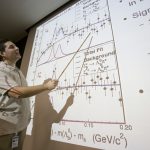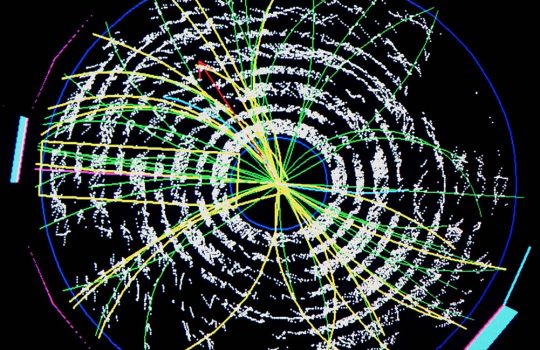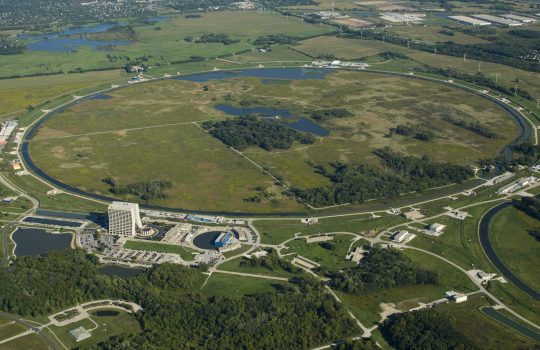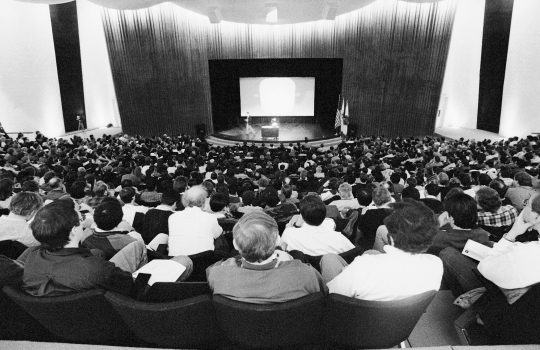Batavia, Illinois – Scientists of the CDF collaboration at the Department of Energy’s Fermi National Accelerator Laboratory announced today (October 23, 2006) the discovery of two rare types of particles, exotic relatives of the much more common proton and neutron.
“These particles, named Sigma-sub-b [Σb], are like rare jewels that we mined out of our data,” said Jacobo Konigsberg, University of Florida, a spokesperson for the CDF collaboration. “Piece by piece, we are developing a better picture of how matter is built out of quarks. We learn more about the subatomic forces that hold quarks together and tear them apart. Our discovery helps complete the ‘periodic table of baryons.'”
Baryons (derived from the Greek word “barys”, meaning “heavy”) are particles that contain three quarks, the most fundamental building blocks of matter. The CDF collaboration discovered two types of Sigma-sub-b particles, each one about six times heavier than a proton.
There are six different types of quarks: up, down, strange, charm, bottom and top (u, d, s, c, b and t). The two types of baryons discovered by the CDF experiment are made of two up quarks and one bottom quark (u-u-b), and two down quarks and a bottom quark (d-d-b). For comparison, protons are u-u-d combinations, while neutrons are d-d-u. The new particles are extremely short-lived and decay within a tiny fraction of a second.
Utilizing Fermilab’s Tevatron collider, the world’s most powerful particle accelerator, physicists can recreate the conditions present in the early formation of the universe, reproducing the exotic matter that was abundant in the moments after the big bang. While the matter around us is comprised of only up and down quarks, exotic matter contains other quarks as well.
The Tevatron collider at Fermilab accelerates protons and antiprotons close to the speed of light and makes them collide. In the collisions, energy transforms into mass, according to Einstein’s famous equation E=mc2. To beat the low odds of producing bottom quarks–which in turn transform into the Sigma-sub-b according to the laws of quantum physics–scientists take advantage of the billions of collisions produced by the Tevatron each second.
“It’s amazing that scientists can build a particle accelerator that produces this many collisions, and equally amazing that the CDF collaboration was able to develop a particle detector that can measure them all,” said CDF cospokesperson Rob Roser, of Fermilab. “We are confident that our data hold the secret to even more discoveries that we will find with time.”
The CDF experiment identified 103 u-u-b particles, positively charged Sigma-sub-b particles (Σ+b), and 134 d-d-b particles, negatively charged Sigma-sub-b particles (Σ–b). In order to find this number of particles, scientists culled through more than 100 trillion high-energy proton-antiproton collisions produced by the Tevatron over the last five years.
In a scientific presentation on Friday, October 20, CDF physicist Petar Maksimovic, professor at Johns Hopkins University, presented the discovery to the particle physics community at Fermilab. He explained that the two types of Sigma-sub-b particles are produced in two different spin combinations, J=1/2 and J=3/2, representing a ground state and an excited state, as predicted by theory.
Quark theory predicts six different types of baryons with one bottom quark and spin J=3/2 (see graphic). The CDF experiment now accounts for two of these baryons.
CDF is an international experiment of 700 physicists from 61 institutions and 13 countries. It is supported by the Department of Energy, the National Science Foundation, and a number of international funding agencies. (The full list can be found at http://www-cdf.fnal.gov/collaboration/Funding_Agencies.html.) Using the Tevatron, the CDF and DZero collaborations at Fermilab discovered the top quark, the final and most massive quark, in 1995.
Fermilab is a national laboratory funded by the Office of Science of the U.S. Department of Energy, operated under contract by Universities Research Association, Inc.
- The Fermilab accelerator complex accelerates protons and antiprotons close to the speed of light. The Tevatron, four miles in circumference, is the world’s most powerful accelerator, producing collisions at the energy of 2 tera electron volts (TeV). In a tiny volume, these collisions recreate the conditions of the early universe. Two experiments, CDF and DZero, record the particles emerging from billions of collisions per second.
- he CDF detector, about the size of a 3-story house, weighs about 6,000 tons. Its subsystems record the “debris” emerging from high-energy proton-antiproton collisions, unveiling the secrets of the early universe. The detector surrounds the collision point and records the path, energy and charge of exotic, short-lived particles emerging from the collisions.
- The center of the upgraded CDF detector features a silicon vertex detector, installed in January 2001. The improved detector has taken data since March 2001. The vertex detector allows experimenters to record tracks of charged particles with utmost precision. Tracing the particle tracks back to their origin, scientists discover what processes take place at the core of proton-antiproton collisions.
- Six quarks–up, down, strange, charm, bottom and top–are the building blocks of matter. Protons and neutrons are made of up and down quarks, held together by the strong nuclear force. The CDF experiment has discovered exotic relatives of the proton and neutron, particles that include a bottom quark.
- Baryons are particles made of three quarks. The particles can exist in a ground state (J=1/2) and an excited state (J=3/2). The CDF experiment discovered the positively charged Sigma-sub-b and the negatively charged Sigma-sub-b in both spin configurations. The graphic shows the various three-quark combinations with J=3/2 that are possible using the three lightest quarks–up, down and strange–and the bottom quark. Past experiments discovered all of the baryons made of light quarks. The CDF discovery is the first observation of baryons with one bottom quark and spin J=3/2. Theory predicts four more such particles to exist. There are additional baryons involving the charm quark, which are not shown. The top quark, discovered at Fermilab in 1995, is too short-lived to become part of a baryon.
- In a scientific presentation on Friday, October 20, CDF physicist Petar Maksimovic, professor at Johns Hopkins University, presented the discovery to the particle physics community at Fermilab. He explained that the two types of Sigma-sub-b particles are produced in two different spin combinations, J=1/2 and J=3/2, representing a ground state and an excited state, as predicted by theory.
CDF institutions:
1. Academia Sinica, Taipei, Taiwan
2. Argonne National Laboratory, Argonne, Illinois
3. Institut de Fisica d’Altes Energies (IFAE-Barcelona), Spain
4. Baylor University, Waco, Texas
5. Brandeis University, Waltham, Massachusetts
6. University of California at Davis, Davis, CA
7. University of California at Los Angeles, Los Angeles, CA
8. University of California at San Diego, San Diego, CA
9. University of California at Santa Barbara, Santa Barbara, CA
10. Instituto de Fisica de Cantabria, CSIC-University of Cantabria, Santander, Spain
11. Carnegie Mellon University, Pittsburgh, PA
12. University of Chicago, Chicago, Illinois
13. Joint Institute for Nuclear Research, Dubna, Russia
14. Duke University, Durham, North Carolina
15. Fermi National Accelerator Laboratory (FNAL), Batavia, Illinois
16. University of Florida, Gainesville, Florida
17. University of Geneva, Switzerland
18. Glasgow University, United Kingdom
19. Harvard University, Cambridge, Massachusetts
20. University of Helsinki, Finland
21. University of Illinois, Urbana, Illinois
22. INFN, University of Bologna, Italy
23. INFN, Laboratori Nazionali di Frascati, Italy
24. INFN Sezione di Padova, Universita di Padova, Italy
25. INFN, University and Scuola Normale Superiore of Pisa, Italy
26. INFN, University di Roma I, Italy
27. INFN, Trieste, Italy, and Universita di Udine, Italy
28. IPP, Institute of Particle Physics, McGill University, Montréal, Canada
29. University of Toronto, Canada
30. ITEP, Institute for Theoretical and Experimental Physics, Moscow, Russia
31. The Johns Hopkins University, Baltimore, Maryland
32. Universitaet Karlsruhe, Germany
33. National Laboratory for High Energy Physics (KEK), Tsukuba, Japan
34. The Center for High Energy Physics(CHEP) Kyungpook National University, Seoul National University, and SungKyunKwan University, Korea
35. Lawrence Berkeley National Laboratory (LBNL) Berkeley, California
36. University of Liverpool, United Kingdom
37. University College London, United Kingdom
38. CIEMAT, Madrid, Spain
39. Massachusetts Institute of Technology (MIT), Cambridge, Massachusetts
40. Michigan State University, East Lansing, Michigan
41. University of Michigan, Ann Arbor, Michigan
42. University of New Mexico, Albuquerque, New Mexico
43. Northwestern University, Evanston, Illinois
44. The Ohio State University, Columbus, Ohio
45. Osaka City University, Japan
46. Okayama University, Japan
47. University of Oxford, United Kingdom
48. CNRS-IN2P3, LPNHE, Paris, France
49. University of Pennsylvania, Philadelphia, Pennsylvania
50. University of Pittsburgh, Pittsburgh, Pennsylvania
51. Purdue University, West Lafayette, Indiana
52. University of Rochester, Rochester, New York
53. Rockefeller University, New York, New York
54. Rutgers University, Piscataway, New Jersey
55. Texas A&M University, College Station, Texas
56. Tufts University, Medford, Massachusetts
57. University of Tsukuba, Tsukuba, Japan
58. Waseda University Tokyo, Japan
59. Wayne State University, Detroit, Michigan
60. University of Wisconsin, Madison, Wisconsin
61. Yale University, New Haven, Connecticut

